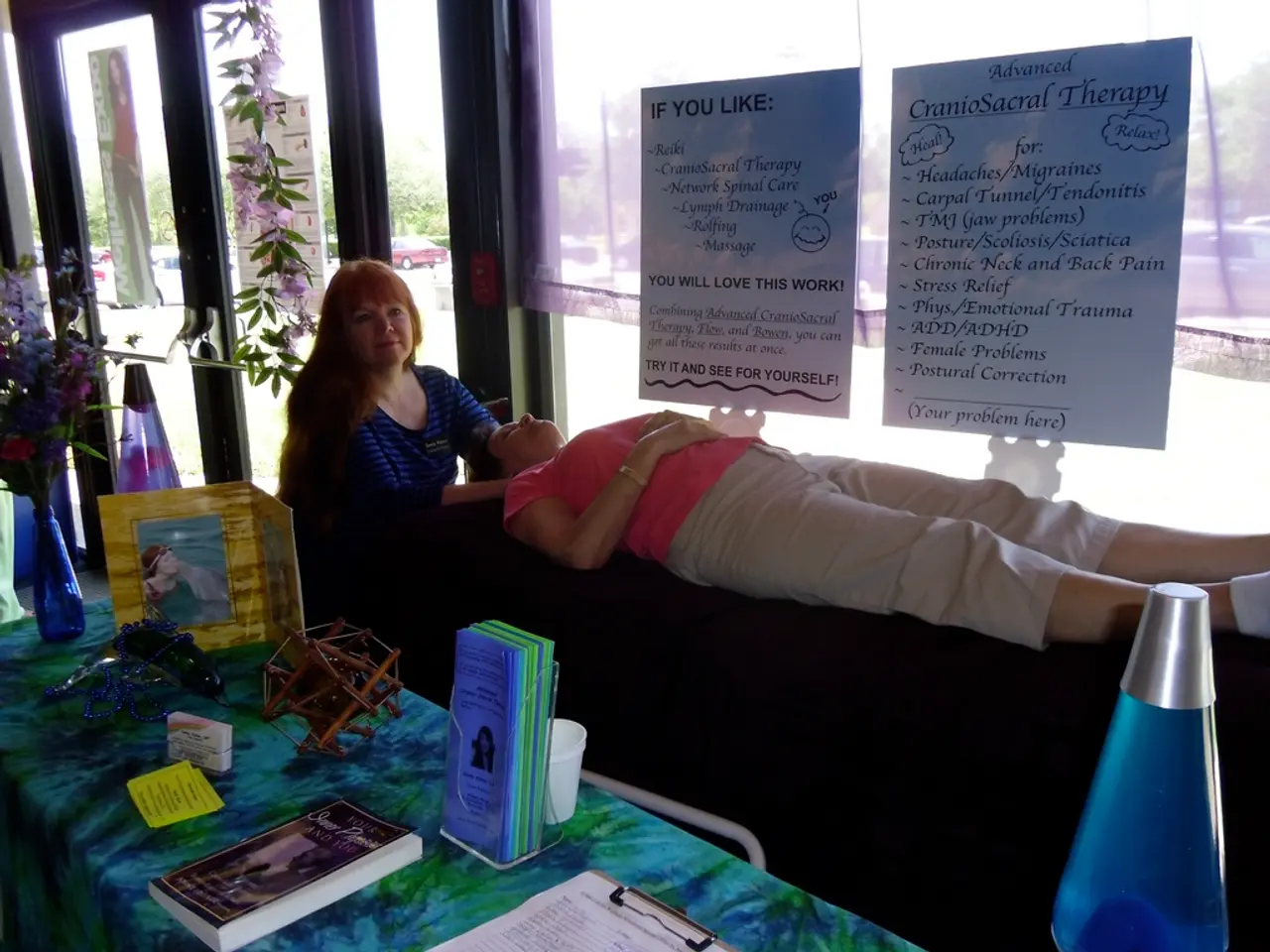Wheezing from allergies: Identification, evaluation, and remedy solutions
When someone encounters an allergic reaction, they may produce a high-pitched sound, often referred to as wheezing. This happens when the throat and lungs constrict, making it tougher for the body to take in air, especially when exhaling. Here, we dive into the causes, symptoms, and treatments of wheezing associated with allergies, allergic asthma, and anaphylactic shock.
Allergies and Wheezing
Various factors can trigger wheezing, and accurate identification is crucial for effective treatment. These factors include:
Allergic reactions
Allergic reactions are the body's response to a foreign substance, called an allergen, that it misperceives as harmful. Allergens like pollen, dust, pet hair, certain foods, insect stings, and medications can all potentially cause wheezing.
Inflammation of the airways
When the body encounters an allergen, it generates antibodies and chemicals like histamine, which lead to airway inflammation and constriction. The release of histamine also triggers mucus production to help expel the allergen. This inflammation results in narrower airways, and the air forced through them can create a high-pitched whistling sound — the sound known as wheezing.
Symptoms
The duration and severity of wheezing symptoms can vary, with some lasting only a short time and others being more prolonged or severe.
Allergic wheezing
The most prominent symptom of allergic wheezing is the whistling sound itself. It's often described as high-pitched, musical, whistle-like, or squeaky. This sound is most noticeable during exhalation and may be accompanied by a cough and chest pressure. In some cases, allergic reactions can cause stridor, a high-pitched sound due to difficulty taking air into the body.
Allergic asthma
Not everyone with allergic wheezing has allergic asthma, but many people who have asthma experience attacks triggered by allergens. In fact, allergic asthma is the most common type of asthma, affecting approximately 60% of people with the condition. Beyond wheezing, symptoms of allergic asthma usually include coughing, shortness of breath, rapid breathing, and chest tightness.
Anaphylactic shock
People with more severe allergies can have a life-threatening reaction called anaphylactic shock. In such cases, immediate medical attention is necessary. Wheezing that accompanies difficulty breathing, rapid breathing, a bluish tint to the skin, and swelling of the face or lips may indicate anaphylactic shock.
Other underlying conditions
While allergic reactions are the most common cause of wheezing, it can also stem from underlying conditions such as infections, chronic obstructive pulmonary disease (COPD), or heart disease. If a person has no history of allergies or asthma and experiences recurrent wheezing, they should consult a doctor for proper diagnosis and treatment.
Diagnosis
To diagnose the cause of wheezing, a doctor will perform a physical exam and then assess lung function by measuring how much air moves in and out when a person breathes. If necessary, the doctor may administer bronchodilators, a medication that helps open airways, or other tests such as chest X-rays, CT scans, skin tests, or blood tests for specific allergies.
Treatment
Treatment for wheezing depends on the underlying cause: allergies, allergic asthma, anaphylactic shock, or other medical conditions.
Seasonal or environmental allergy treatments
Examples of common treatments for allergic wheezing caused by seasonal or environmental allergens include:
- Medications to alleviate symptoms: Antihistamines, decongestants, and mast cell stabilizers can help reduce airway inflammation and narrowing during an allergic reaction.
- Environmental controls: People with allergies to dust mites can minimize the impact by cleaning carpets, bedding, and furnishings and reducing household humidity. Allergy sufferers sensitive to pet hair can minimize impact by regular vacuuming or limiting pet access to certain areas of the home.
- Avoiding known allergens: People with food allergies can opt for substitutes or eliminate troublesome foods from their diet, while those with pollen allergies can use air purifiers and allergy-proof bedding to minimize symptoms.
Allergic asthma treatments
Most people with asthma respond best to a combination of two types of treatment:
- Quick-relief medicines that expand the airways: Inhaled beta-2 agonists and anticholinergics can provide short-term relief from wheezing, coughing, and breathing difficulties.
- Long-acting drugs to prevent symptoms: Inhaled corticosteroids and immunomodulators can help reduce airway inflammation and prevent symptoms over time.
Anaphylactic shock treatments
In the case of anaphylactic shock, immediate medical attention is crucial. People with known allergies may carry epinephrine auto-injectors, which should be administered as soon as symptoms arise. Until help arrives, it is important to:
- Lay the person down
- Administer the epinephrine injection if available
- Remove the allergen, if known
If the epinephrine injection is not available, emergency responders will provide an adrenaline shot when they arrive on the scene. Proper management of allergic reactions, allergic asthma, and anaphylactic shock can help improve quality of life and avoid life-threatening consequences.
- Allergic reactions to allergens such as pollen, dust, pet hair, some foods, insect stings, and medications can potentially cause wheezing.
- Inflammation of the airways due to allergic reactions leads to the production of histamine, which causes airway constriction and mucus production.
- The high-pitched whistling sound, or wheezing, results from the narrower airways forcing air through them.
- Allergic wheezing symptoms may include a whistling sound, cough, and chest pressure.
- Allergic asthma, affecting around 60% of people with the condition, is often a result of allergic wheezing and is characterized by coughing, shortness of breath, rapid breathing, and chest tightness.
- Anaphylactic shock, a life-threatening reaction to severe allergies, may present with wheezing, difficulty breathing, rapid breathing, a bluish tint to the skin, and swelling of the face or lips.
- Recurrent wheezing in a person with no history of allergies or asthma might indicate an underlying condition such as infections, COPD, or heart disease, and necessitates a doctor's consultation.
- To diagnose the root cause of wheezing, a doctor will perform a physical exam, lung function tests, and potentially administer bronchodilators, chest X-rays, CT scans, skin tests, or blood tests for specific allergies.
- Medications like antihistamines, decongestants, and mast cell stabilizers can help reduce airway inflammation and narrowing during an allergic reaction.
- Environmental controls such as cleaning, reducing humidity, and limiting pet access can minimize the impact of allergies on a person's health.
- People with allergies to specific foods can opt for substitutes or eliminate troublesome foods from their diet, while those with pollen allergies can use air purifiers and allergy-proof bedding to alleviate symptoms.
- Inhaled beta-2 agonists and anticholinergics can provide short-term relief from wheezing, coughing, and breathing difficulties for people with asthma.
- Long-term airway inflammation prevention can be achieved with inhaled corticosteroids and immunomodulators for people with asthma.
- People with severe allergies may carry epinephrine auto-injectors to administer immediately during anaphylactic shock.
- In an anaphylactic shock emergency, it is crucial to lay the person down, administer the epinephrine injection if available, remove the allergen if known, and wait for professional medical assistance.
- Identifying and addressing the underlying cause of wheezing can greatly improve the quality of life and prevent life-threatening consequences for individuals with allergies, allergic asthma, or anaphylactic shock.
- Additionally, individuals with chronic diseases like arthritis, depression, psoriatic disease (including psoriasis), cancer, dermatitis, or neurological disorders may experience respiratory conditions or hear loss due to treatments, making health and wellness, workplace-wellness programs, and medical-condition-specific therapies and treatments essential.
- Adopting fitness and exercise, skin care, mental health maintenance, nutrition, and cardiovascular health practices can also contribute to a comprehensive approach to overall well-being that addresses chronic diseases and various health issues such as eye health, hearing, and more.




